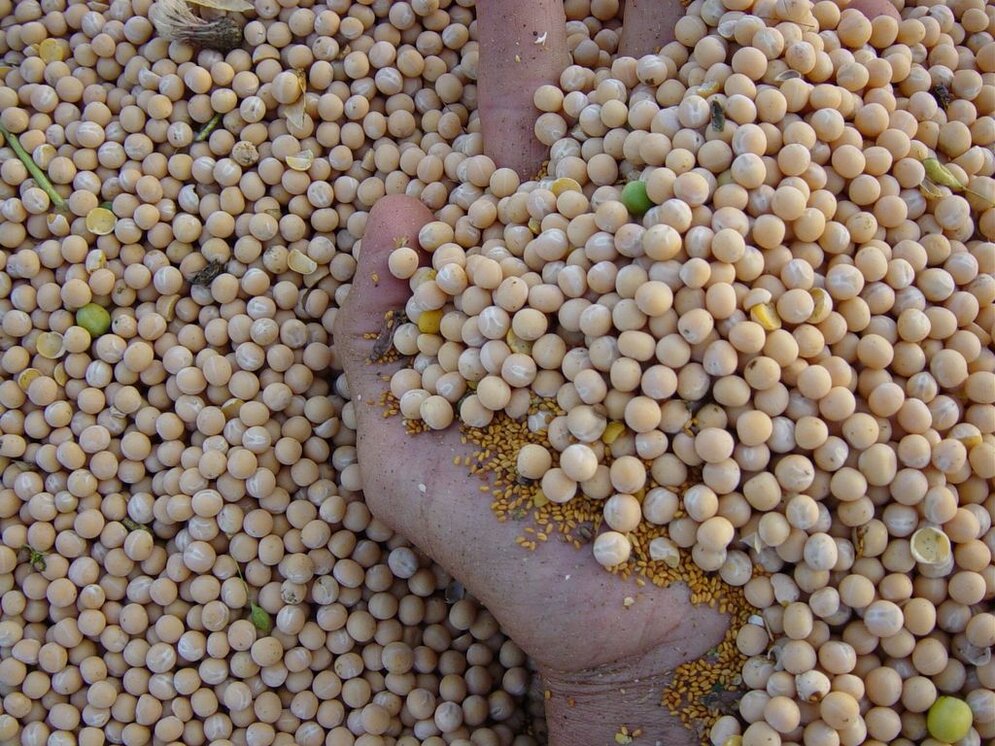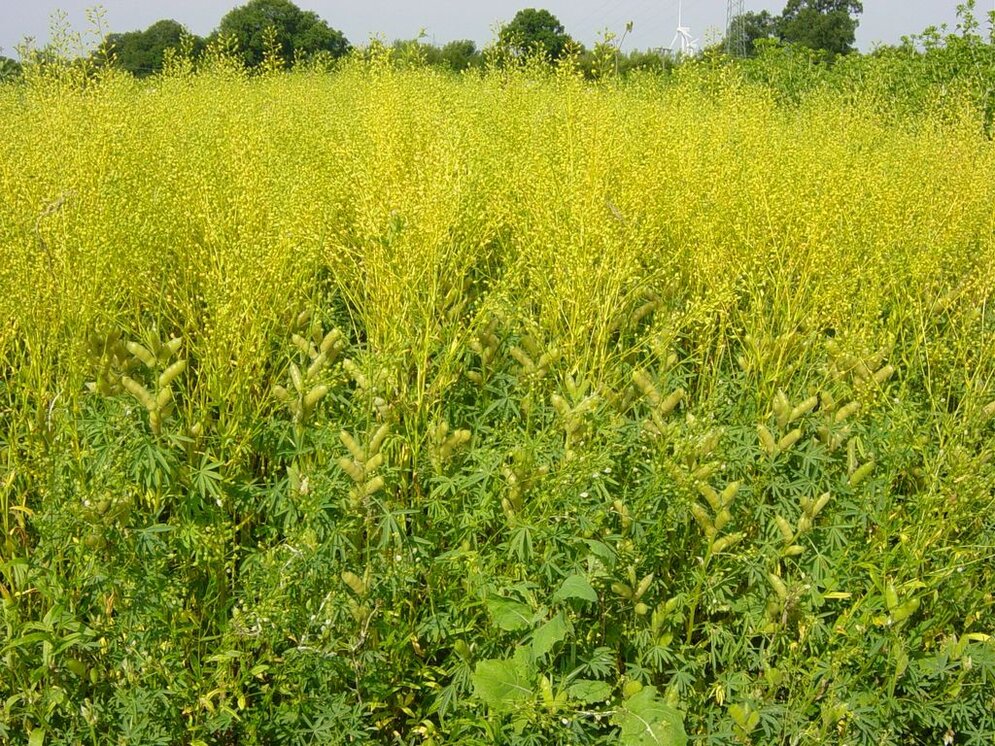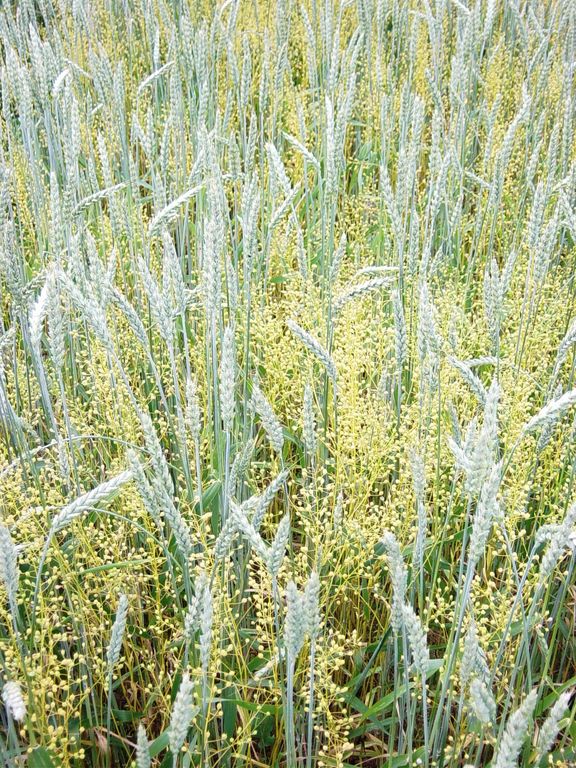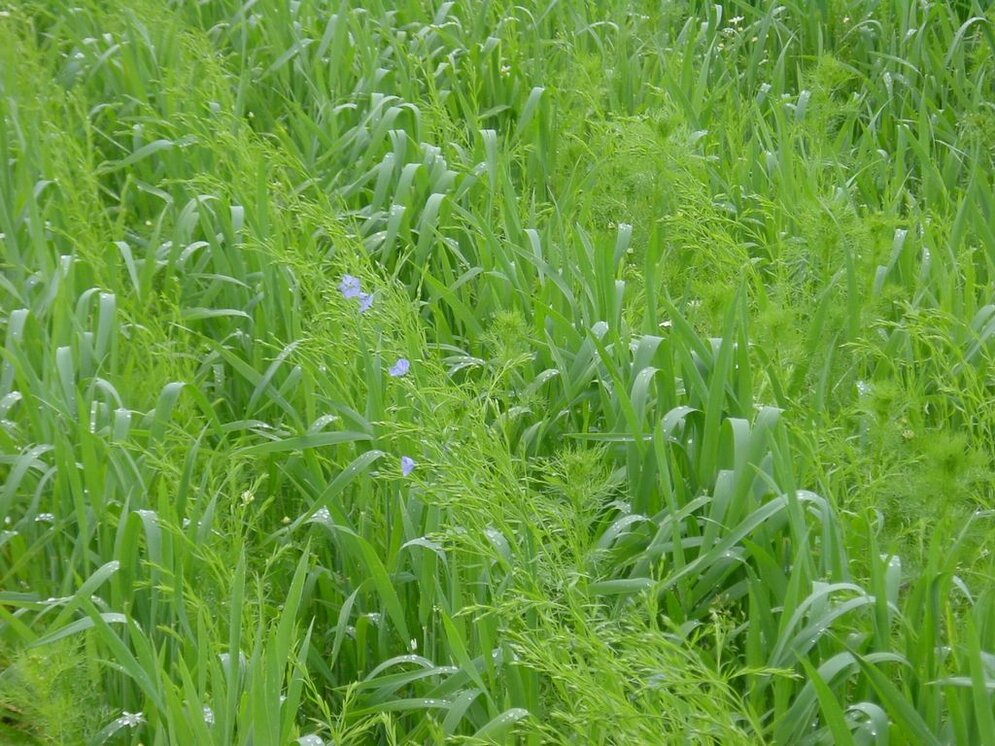Project
Growing oil crops together with other crops
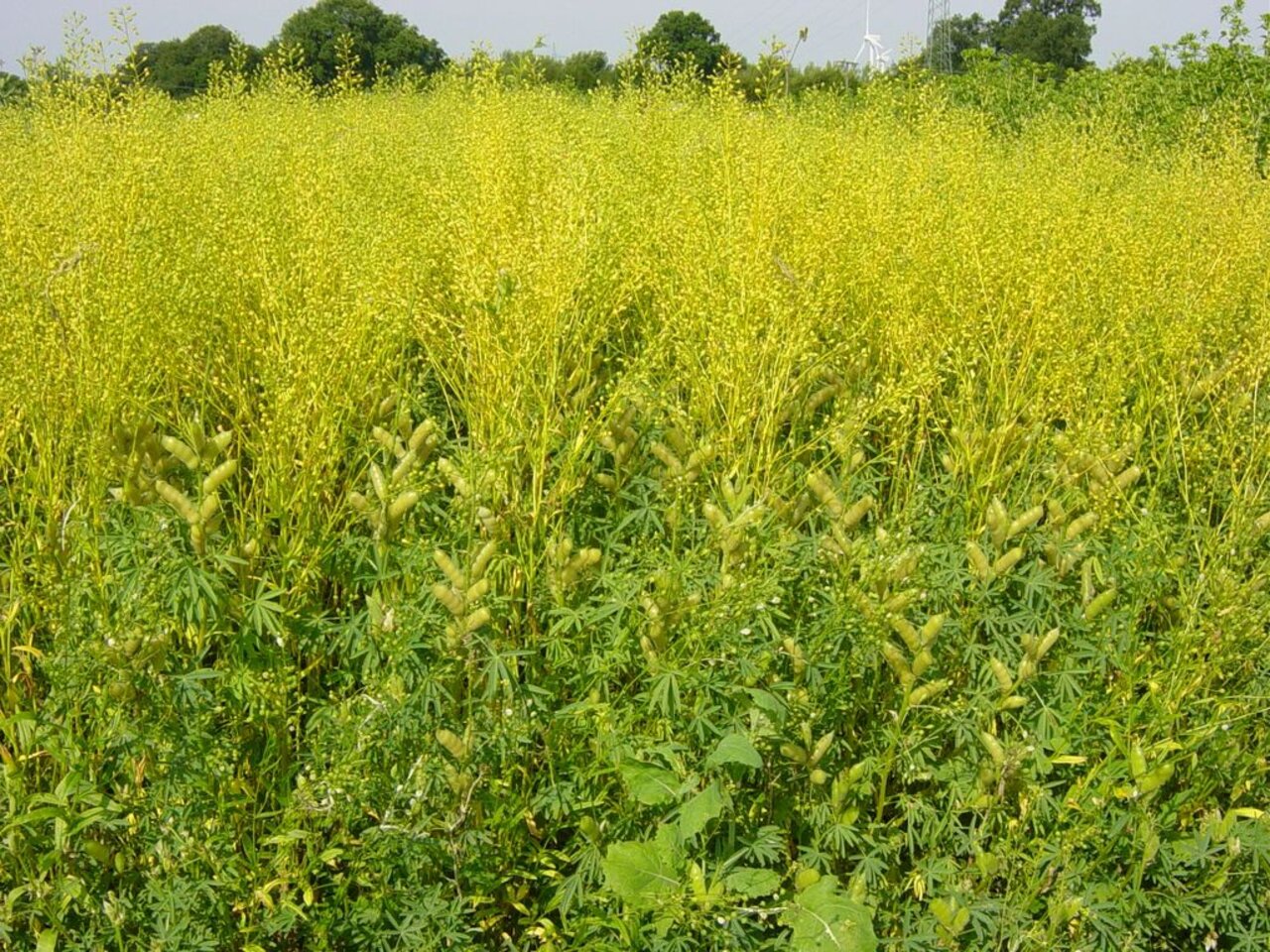
Mixed cropping with oil crops as a tool to increase the area productivity in organic farming - nutrient supply, weed suppression, pests and diseases and product quality (BÖL 03OE113)
Oil crop yields in organic crop rotations are limited by severe cropping risks like insect pests and weed pressure. But organic vegetable oil has high market prices and oil cakes are valuable feedstuffs in livestock production. Mixed cropping - that is the parallel production of more than one crop on one field - might lower these yield risks. We analysed if oil crops are suitable partners in mixed cropping with cereals or legumes.
Background and Objective
In agricultural practice first experiences on mixed cropping of false flax (Camelina sativa L. Crantz) together with field peas or spring cereals existed. In our research project we tested these and also new crop combinations. We systematically determined yields, product qualities, nutrient demand, shadowing of soil surface, weed suppression and insect pests in the mixed cropping systems.
Approach
In fields under organic management we conducted plot trials for two years at four sites in Germany. As spring crops we tested mixtures of semi-leafless peas (Pisum sativum L.) with false flax (Camelina sativa L. Crantz), white mustard (Sinapis alba L.) or spring oilseed rape (Brassica napus L.); mixtures of blue lupines (Lupinus angustifolius L.) with false flax or safflower (Carthamus tinctorius L.); mixtures of spring wheat (Triticum aestivum L.) with linseed (Linum ustitatissivum L.) or false flax. In winter crops we performed mixed cropping with winter oilseed rape (Brassica napus L.) combined with winter barley (Hordeum vulgare L.), winter rye (Secale cereale L.) or winter peas (Pisum sativum convar. speciosum). We compared the results of the mixed cropping systems with the results of plots with each of the components in single cropping. The following parameters were assessed:
- Seed and straw yields,
- weed population and weed cover,
- leaf area index,
- N-, P-, K-, Mg- and S-contents in seeds and straw,
- plant uptake of these elements and
- different quality parameters of seeds, oils and oilcakes.
Regarding pest occurrence we focussed on insect pests in oilseed rape and their natural predators. Furthermore, we assessed the use of mixed cropping systems with oil crops and practical experiences on farms by means of a questionnaire. We evaluated seeding techniques of mixed cultures and developed a special seed drill.
Results
1. Mixed cropping with oil crops stabilises yields.
Due to the different locations and years we found high yield differences in all crops. In most oil crops we found low yield levels which are typical for organic systems. Yields of spring rapeseed were almost completely destroyed by pest insects in all years.
In the mean of all sites we determined elevated yields of mixed cropping systems at all and also of most of its single components, when related to the same used cropping area. Compared to the other crop combinations especially mixtures of false flax and field peas were comparatively stable.
The components of the mixture of blue lupines with safflower had significantly different ripening times. All other combinations showed acceptable consistencies in maturity. So pre harvest losses from ripe seeds were avoided in these mixtures.
In total mixed cropping reduced the high yield risk of oil crops and increased average area yields.
2. Farmers think positively about mixed cropping with oil crops.
In the last few years (before 2006) mixed cropping systems with oil crops had growing popularity in Germany, especially in the federal state of Bavaria. We conducted a survey to evaluate the practical experiences and problems of the farmers. They take positive stock of the mixed cropping systems. However problems in the technical sector and in marketing were reported. In many cases the mixed cropping systems – mainly with false flax – are already integrated in the operating procedure. There was a strong demand for further research. Many farmers planned a conversion of their tractors engine to straight vegetable oils as an alternative to fossil fuel.
3. Economics of organic oil crop production must be improved.
We analysed economics and occurence of different oil crops in organic farming in Germany. At present oilseeds have only a small share in organic farming. The most important oilseeds in Germany are winter rape, sunflower and linseed. They are used predominantly for the extraction of edible oil. Low yields and low profitability are the reason for the small shares of oilseeds in organic farming. We compared the economics of cereals with different oil crops. It became obvious that oilseeds can only compete with cereals if higher yield levels are reached. The product price is less important. Mixed cropping with oil crops (e.g. wheat - linseed, field peas - false flax) yields are elevated and might improve economics of wheat cropping.
4Mixed cropping with oil crops increases plant nutrient demand.
In our trials we could analyse nutrient contents of a range of organic grown crops at different sites for the first time (N, P, K, Mg and S contents of seeds and straw). Thresholds for sufficient nutrient contents in plant material are only defined for high yields in conventional production. In general we found in our organic crops that these thresholds were not reached.
Nutrient concentrations of plants from mixed cropping systems were frequently elevated compared to sole cropping systems. Nutrient uptake of mixed cropping systems increased, compared to the uptake that was reached at least in one sole cropped component of the mixtures. This elevated nutrient demand of mixed cropping should be considered in the planning of crop rotations and fertilisation.
5. Quality parameters of oilseeds are marginally influenced by mixed cropping
In the project we investigated influence of year and location of cultivation as well as of mixture partners on the quality of oilseeds. Oil content, composition of fatty acids, sterols and tocopherols, content of sinapine and glucosinolates and the sensory evaluation were used as parameters for the assessment. Both year and location of cultivation influenced the quality parameters and interfered partially. Legumes or cereals did not affect the quality of the investigated oilseeds im mixed cropping compare to sole cropping. Only for the mixture linseed-false flax a noticeable effect of the cropping system was determined. Oil content of false flax was higher in the mixture with linseed, compared to sole cropping. Additionally false flax seeds showed a higher content of alpha-linolenic acid when cultivated in the mixture. This effect was not found for linseed. False flax oil from sole cropping had a lower sensory quality than oil from mixed cropping.
6. Seed quality of cereals changes in mixed cropping with oil crops
In spring wheat combined with false flax or linseed seed development, protein- and gluten content were increased compared to spring wheat from sole cropping. In the evaluated crop mixtures, half of the spring wheat was replaced by oilseeds. Apparently competition between alternating seed rows of different cultures was lower than between rows of mono cropped spring wheat.
By contrast, a reduced seed development in winter rye and winter barley was observed when grown in mixed cropping with winter rape. Obviously winter rape is highly competitive to cereals in mixtures, even at halved seed densities.
7. Mixed cropping systems suppress’ weeds
We also analysed how weed suppression can be increased by mixed cropping systems. When sole cropped oil seeds were compared, weed covering increased in the following order: white mustard, winter rape, false flax, safflower, linseed.
By mixed cropping these oil crops with other grain crops, weed suppression could be consistently increased. Lower weed covering was determined in plots with mixtures of peas with white mustard or false flax compared to sole cropped peas; mixtures of blue lupins with safflower or false flax compared to sole cropped lupins; mixtures of linseed with spring wheat or false flax compared to sole cropped linseed, and mixtures of winter rape with winter barley or winter rye compared to winter rape in sole cropping.
Our determinations of leaf area indices hint for the fact that weed suppression is not only caused by competition for light.
8. High insect pest infestation of oilseed rape were partly reduced in mixed cropping with cereals.
Pest occurrences and infestations were investigated in organic oilseed rape in pure stands and in mixed cropping systems at all four sites. Additionally, we determined the kind and amount of parasitism of wasps in larvae of harmful insects.
In most cases, mixed cropping did not reduce insect pest infestations. Only a weak tendency for the reduction of harmful insects in oilseed rape could be ascertained in mixed cropping with cereals. But in some cases a higher amount of parasitism by wasps (Tersilochus heterocerus, Phradis interstitialis) was found in larvae of pollen beetle (Meligethes aeneus) and rape stem weevil (Ceutorhynchus napi) in mixed cropping systems compared to mono cropped rapeseed. For conclusive recommendations additional studies are necessary. The investigation showed rape stem weevil, cabbage stem weevil (C. pallidactylus) and pollen beetle are important problems in organic rapeseed production. Appropriate methods to reduce infestations have to be found.
9. With special seed drill technology mixed cropping systems can be effectively established.
Mixed cropping systems with oilseeds need adapted seeding systems. In most cases different seed sizes have to be drilled in different depths. Seed mixtures in the seed box are not suitable for these cases. Intermittent systems, like broadcasting of the fine seeds after drilling the first component of the mixtures or a complete second drill step, are possible. Seed distribution and/or seed depths are, however, not homogeneous with these practices. Combined systems, like a simple coupling of a second seed drill or the mounting of additional seed hoppers, offer the possibility to sow mixed cropping systems in one operation. For an optimal sowing with uniform distribution, each seed component of the mixtures needs a density regulation and a high number of depth-controlled drill coulters. If the seed allocation to the different coulters is variable, different mixed cropping systems can be drilled with adopted distribution and seeding depth for each crop in the mixture. A prototype of a seeding machine was developed by practice partners during the project.
Thünen-Contact

Involved external Thünen-Partners
- Max Rubner-Institut, Bundesforschungsinstitut für Ernährung und Lebensmittel (MRI)
(Karlsruhe, Hamburg, Deutschland) -
Landesforschungsanstalt für Landwirtschaft und Fischerei MV
(Gülzow, Deutschland) - Georg-August-Universität Göttingen
(Göttingen, Deutschland) - Julius Kühn-Institut - Bundesforschungsinstitut für Kulturpflanzen (JKI)
(Quedlinburg, Braunschweig, Groß Lüsewitz, Kleinmachnow, Deutschland) -
Technische Universität München
(München, Freising-Weihenstephan, Deutschland) -
IG Mischfruchtanbau
(Pfaffenhofen, Deutschland) - Naturland - Verband für ökologischen Landbau e.V.
(Gräfelfing, Deutschland) -
Gut Wilmersdorf
(Wilmersdorf, Deutschland)
Funding Body
-
Federal Ministry of Agriculture, Food and Regional Identity (BMLEH)
(national, öffentlich)
Duration
3.2004 - 6.2007
More Information
Project funding number: BÖL 03OE113
Funding program: Bundesprogramm Ökologischer Landbau und andere Formen nachhaltiger Landwirtschaft (BÖLN)
Project status:
finished
Publications
- 0
Paulsen HM (2008) Mischfruchtanbausysteme mit Ölpflanzen im ökologischen Anbau : 2. Ertragsstruktur des Mischfruchtanbaus von Lein (Linum usitatissimum L.) mit Sommerweizen, Hafer oder Leindotter. Landbauforsch 58(4):307-314
https://literatur.thuenen.de/digbib_extern/bitv/dk041193.pdf
- 1
Paulsen HM (2007) Mischfruchtanbausysteme mit Ölpflanzen im ökologischen Landbau : 1. Ertragsstruktur des Mischfruchtanbaus von Leguminosen oder Sommerweizen mit Leindotter (Camelina sativa L. Crantz). Landbauforsch Völkenrode 57(1):107-117
https://literatur.thuenen.de/digbib_extern/bitv/dk038115.pdf

![[Translate to English:] [Translate to English:]](/media/_processed_/8/e/csm_Bildschirmfoto_2021-03-03_bearb_fc48ac88bf.jpeg)
![[Translate to English:] [Translate to English:]](/media/_processed_/8/e/csm_Bildschirmfoto_2021-03-03_bearb_ba3ec0e9d7.jpeg)
